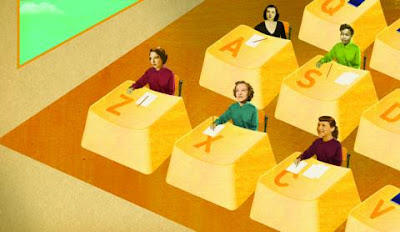Prediction
é uma estratégia de leitura que permite ao leitor prever o que vem a seguir em
um texto. Trata-se do desenvolvimento sequenciado do pensamento. Isso só é
possível porque quem escreve o faz de maneira organizada, porque as pessoas
pensam de maneira semelhante e porque alguns tipos de textos possuem estruturas
previsíveis. Quanto mais experiente for o leitor, maior será sua capacidade em
prever.
Critical Reading:
Ao final de cada leitura, o bom leitor deveria
estar atento para tudo o que lhe foi transmitido através do texto, procurando
avaliar o conteúdo do mesmo mediante perguntas tais como: O texto é interessante?
por que? A leitura do texto acrescentou algo novo aos seus conhecimentos? O
texto foi apresentado de modo objetivo, superficial, profundo, confuso...? Você
discorda ou concorda com as ideias do autor? O autor foi imparcial ou
tendencioso? Você conseguiu captar alguma Segunda intenção nas entrelinhas do
texto? Você acrescentaria algo que não foi mencionado
Contextual
Reference:
Normalmente existem no texto elementos de referência que são usados para
evitar repetições e para interligar as sentenças, tornando a leitura mais
compreensível e fluente. Esses elementos aparecem na forma de pronomes
diversos: Pessoais: he, she, it, they, etc. Demonstrativos: this,
that, those, such; Relativos: who, whom, whose, that, which;
Adjetivos possessivos: his, her, our. Veja alguns exemplos abaixo:
- I asked my students why they had chosen the
ESP course.
- This description is very simple. It follows a
diagram in numbered stages.
- Geologists use explosive charges and seismic
refraction to find oil storages. - These techniques have proved to be successful in the
desert.
SCIENCE & TECHNOLOGY
1 British
parents may find it difficult to help their children with their Science and
Technology homework. Since the implementation of the National Curriculum in the
late 1980s, the teaching of these disciplines has changed radically.
4 Science
is no longer presented as Physics, Chemistry and Biology to be learnt parrot
fashion, but as a practical discipline requiring communication skills and the
application of knowledge and understanding. Pupils now have to behave like
scientists in and outside the classroom. They learn to communicate, whether
working alone or contributing to a group effort. They learn research skills
such as the use of reference materials. They practice gathering and organizing
information from different sources. They develop the ability to record and
report as well as to translate information from one form to another to suit a
particular audience or purpose. Familiarity with computers is now essential as
pupils are expected to use spreadsheets and databases for collecting and
presenting information.
14Technology, which was previously encountered as an
option at Secondary School and often limited to Technical Drawing, is now
compulsory for pupils aged between five and sixteen. As in Science, the new
approach is based on practice. Pupils are encouraged to identify opportunities
for design and technological activities and to express them verbally. They
learn these abilities in the contexts of home, school, recreation, community
and also business and industry as they approach school-leaving age. They also learn
to generate designs, to plan and make things using appropriate resources and to
evaluate the processes, products and effects of their design and technological
activities. Computer literacy from an early age and the ability to use suitable
software applications such as computer-aided design programs now form important
parts of the Technology syllabus.
http://www.btinternet.com/~ted.power/discsctt.html
Responda as seguintes perguntas sobre o texto acima:
a) No primeiro parágrafo, que disciplinas escolares mudaram radicalmente desde os anos 80?
________________________________________________________________________________________________________________________________________________________________________________________________________________________
b) No segundo parágrafo, como os alunos aprendem
Ciências hoje em dia?
_____________________________________________________________________________________________________________________________________________________________________________________________________________________________________________________________________________________________
c) No terceiro parágrafo (linhas 14, 15 e 16), qual o
contraste apresentado entre o ensino de Tecnologia no passado e atualmente?
_____________________________________________________________________________________________________________________________________________________________________________________________________________________________________________________________________________________________
d) Ainda no terceiro parágrafo, de que forma o
manuseio do computador está inserido no ensino de Tecnologia nas escolas?
_________________________________________________________________________________________________________________________________________________________________________________________________________________________________________________________________________________________________________________________________________________________
4. A quem se referem
os pronomes abaixo e justifique:
Their
(linha1):_____________________________________
Their
(linha1):_____________________________________
These(linha3):_____________________________________
Them(linha19):_____________________________________
5. No início do
parágrafo (linha15) temos o pronome relativo which. A que termo este
pronome se refere?
__________________________________________________________
6. A que se refere IT
na linha 1 ?
__________________________________________________________

